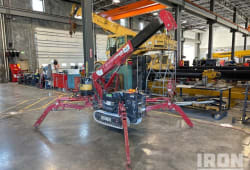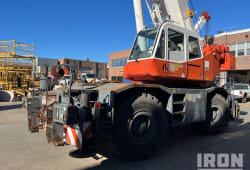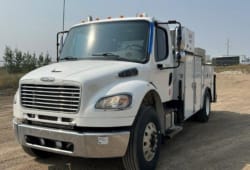Heavy Lifting: Understanding How Cranes Revolutionize Industrial Processes
7 Min read
)
January 20, 2024
Understanding the anatomy of a crane is essential to comprehend its functionality fully. The main components include the boom, which is the horizontal arm that holds the load; the hook or other attachment for lifting; the operator's cab for control; and the counterweights to maintain balance during lifting operations. Additionally, the base or chassis provides stability to the crane, ensuring safe and efficient lifting. The intricate interplay of these components enables cranes to perform a wide array of lifting tasks, from construction projects to the intricate maneuvers required in industrial settings.
Versatility in Construction
Tower cranes play a pivotal role in construction, essential for lifting heavy materials to great heights. With towering booms and impressive lifting capacities, they are the preferred choice for building skyscrapers and tall structures. Their mobility, precision, and capacity make them indispensable for placing heavy steel beams, concrete panels, and other construction materials with ease. The construction industry heavily relies on these cranes to ensure efficient and effective vertical development, showcasing their significance in shaping modern city skylines.
Efficiency in Material Handling
In the realm of industrial operations, the significance of crane technology extends beyond construction projects. It plays a crucial role in material handling within factories and warehouses. Overhead cranes, for instance, enable the seamless movement of heavy goods within a confined space, optimizing the workflow. The ability to precisely position loads enhances efficiency and reduces the risk of damage to goods during transit. These versatile machines embody technological advancements that not only elevate construction capabilities but also contribute significantly to the streamlined functioning of various industrial processes.
Revolutionizing Manufacturing Processes
In manufacturing, cranes play a crucial role in the assembly of large and intricate machinery. Gantry cranes, with their wide spans and high lifting capacities, contribute significantly by facilitating the movement and positioning of heavy components during the manufacturing process. This not only accelerates production but also ensures the safety of workers by minimizing manual handling of bulky items. From lifting raw materials to assembling finished products, cranes streamline operations, enhancing efficiency and precision in manufacturing environments. Their versatility makes them indispensable in various industries, supporting the seamless creation of complex structures and machinery.
Cranes in Shipbuilding
:format(webp))
Industrial cranes are indispensable in various sectors, excelling in tasks that require precision and strength. Found in manufacturing plants, construction sites, and warehouses, these mighty machines efficiently lift and transport heavy loads, facilitating seamless operations. Shipyards are another domain where they showcase their prowess. The construction of massive ships demands the lifting and placement of heavy components like ship hulls, engines, and containers. Shipbuilding cranes, often designed to operate in proximity to water, demonstrate their durability and resilience in challenging maritime environments.
Offshore and Oil Rig Applications
The offshore industry plays a pivotal role in harnessing valuable resources from beneath the ocean floor. In this dynamic environment, cranes are indispensable for a myriad of tasks, including loading/unloading supplies and assembling/maintaining oil rigs. The harsh open sea conditions demand cranes capable of withstanding corrosion and adverse weather. Offshore cranes are meticulously designed to meet these challenges head-on, ensuring reliable performance in the face of nature's unpredictability. Their resilience and efficiency contribute significantly to the seamless exploration and extraction processes, making them vital assets in the relentless pursuit of offshore resource development.
Cranes in Renewable Energy Projects
In the evolving landscape of energy, a significant transition towards sustainable sources is underway. As the world shifts towards sustainable energy sources, it plays a vital role in the installation and maintenance of renewable energy infrastructure. Tower cranes are employed to erect wind turbines, while mobile cranes are used for transporting and assembling components in solar power projects. The versatility of cranes extends to supporting the development of cleaner and more sustainable energy solutions. Embracing innovative technologies and construction methods, the integration of cranes is pivotal in realizing the full potential of environmentally friendly energy initiatives.
Safety Measures and Innovations
Cranes, marvels of engineering, effortlessly lift and transport heavy loads, shaping skylines and facilitating construction globally. Despite their monumental capabilities, it operates in environments where safety is paramount. Advanced safety features, such as load moment indicators and anti-collision systems, contribute to accident prevention. Innovations in crane technology also include remote control operation, allowing operators to maintain a safe distance during critical lifting operations. These advancements underscore the commitment to both efficiency and safety in the dynamic world of construction and heavy industry.
Challenges in Crane Operation
The advent of advanced crane technologies has revolutionized industrial processes, optimizing efficiency and precision. These sophisticated machines, however, present challenges necessitating meticulous consideration. Factors like load stability, site conditions, and environmental variables demand assessment to ensure the safety and efficiency of crane operations. To address these challenges, proper training for crane operators is imperative. This not only mitigates potential risks but also contributes significantly to overall job site safety. While technological advancements bring remarkable benefits, a proactive approach in training and evaluation remains vital to navigate the intricacies of crane operations successfully.
Future Trends in Crane Technology
The world of cranes continues to evolve with advancements in technology. Traditional crane operations are undergoing a profound transformation through the integration of automation, artificial intelligence, and telematics. Smart cranes, equipped with sensors and data analytics capabilities, are becoming increasingly prevalent. These technological innovations empower cranes to offer real-time insights into performance, maintenance needs, and overall operational efficiency. As we navigate the 21st century, the marriage of cutting-edge technology with the robust functionality of cranes ensures a safer, more efficient, and forward-looking landscape for construction and heavy lifting industries.
Environmental Considerations
The construction industry continues to evolve with technological advancements. Innovations like autonomous machinery, augmented reality in project planning, and advanced materials are reshaping the way buildings are constructed. In the wake of growing environmental awareness, the crane industry is also making strides towards sustainability. Electric-powered cranes and those using alternative fuels are gaining popularity, reducing emissions and minimizing the environmental impact of crane operations. The industry's commitment to eco-friendly practices aligns with the broader global efforts towards a greener future. As construction methods embrace eco-conscious solutions, the future promises a harmonious balance between infrastructure development and environmental stewardship.
Global Impact of Crane Technology
Construction cranes, towering symbols of progress, dominate skylines globally. These mechanical behemoths, with their impressive reach and lifting capabilities, play a pivotal role in modern construction. The influence of this extends far beyond individual construction sites. Their role in shaping urban landscapes, supporting industries, and contributing to infrastructure development has a profound impact on economies worldwide. The efficiency and speed with which it operates directly influence project timelines, making them indispensable in meeting the demands of rapidly growing populations. These colossal machines are not just builders; they are architects of economic growth and urban transformation.
Conclusion
In conclusion, cranes stand as towering symbols of industrial progress, playing a pivotal role in shaping the modern world. From construction and manufacturing to offshore exploration and renewable energy projects, cranes have become indispensable in revolutionizing industrial processes. As technology continues to advance, the capabilities of cranes will likely expand, further enhancing their efficiency, safety features, and environmental sustainability. The heavy lifting prowess of this is not just a testament to engineering marvels but a driving force behind the evolution of industries and the infrastructure that supports our interconnected world.

Samir Shah is the Co-Founder and Chief Product Officer of Boom & Bucket, where he leads the development of innovative solutions for buying and selling heavy equipment. With a background in engineering, product development, and business strategy, Samir has a track record of taking companies from concept to market success. Previously, he was the Head of Cat Digital Labs at Caterpillar, overseeing digital initiatives and product launches. He holds degrees from MIT Sloan and Carnegie Mellon, and he is passionate about tackling big challenges in underserved industries.














